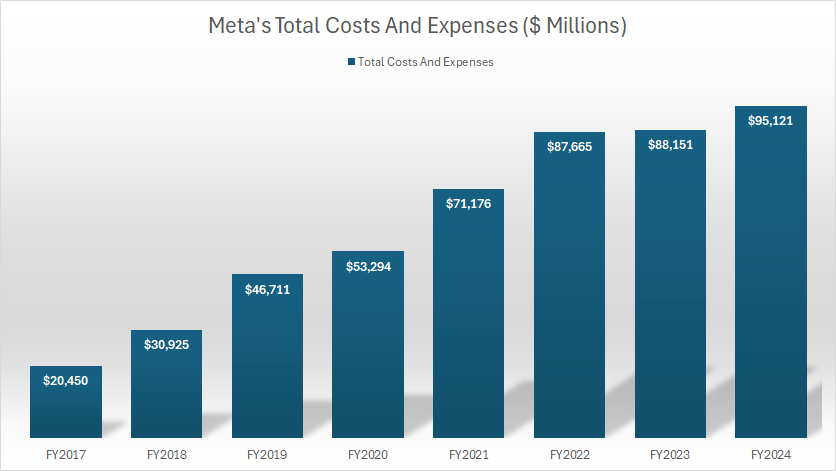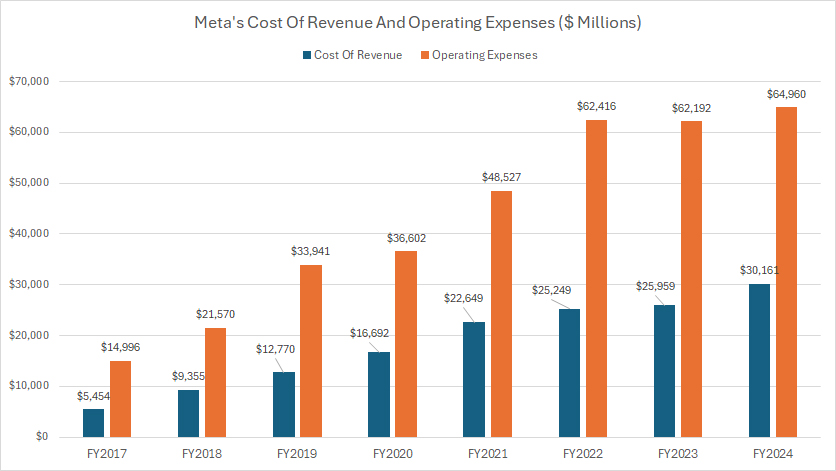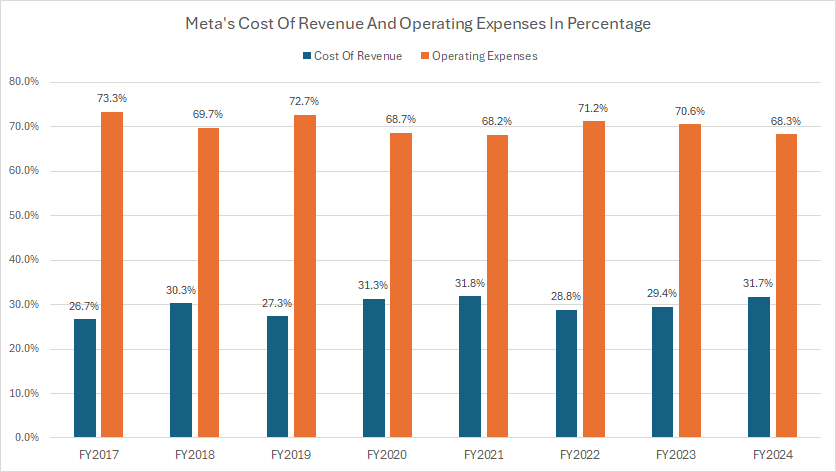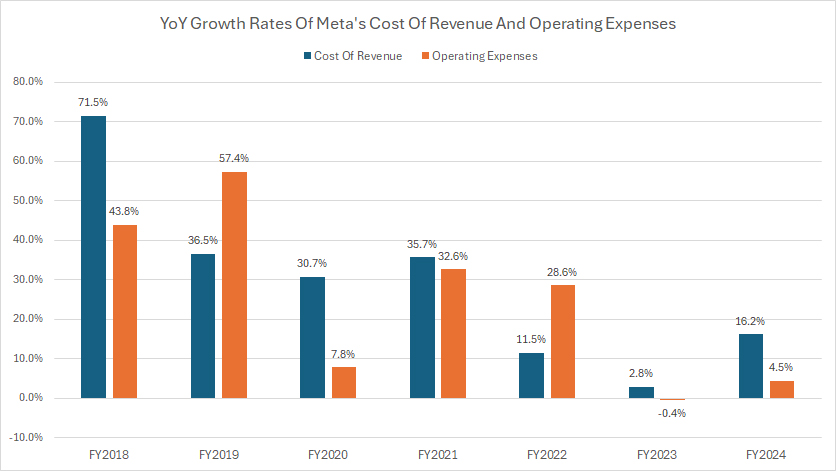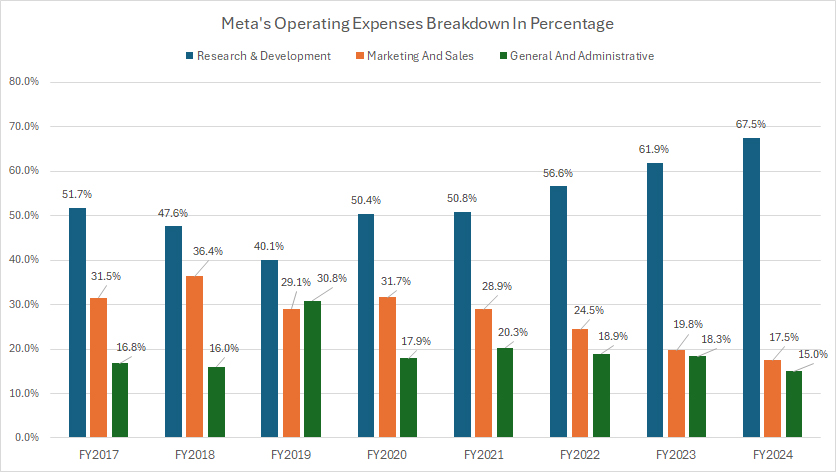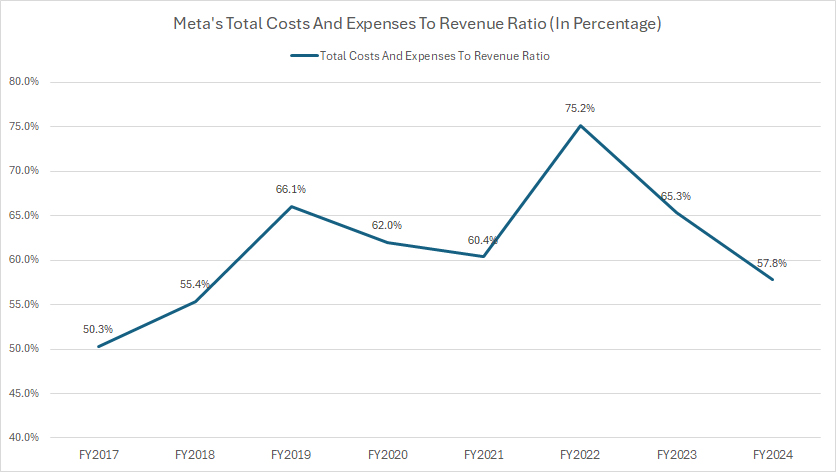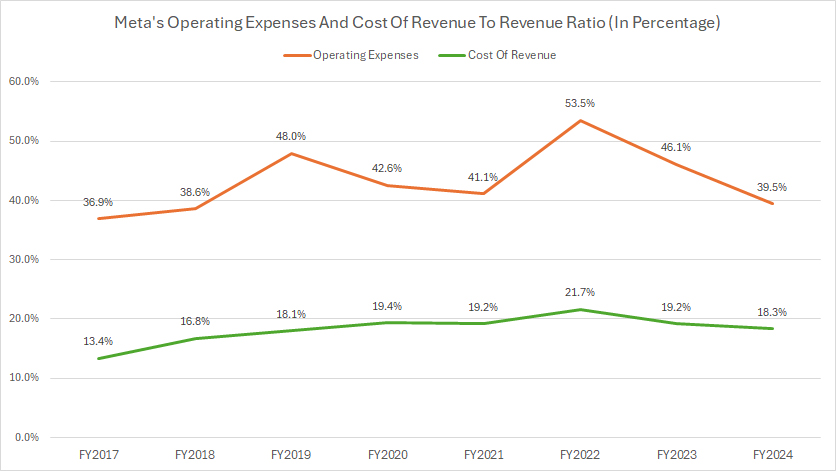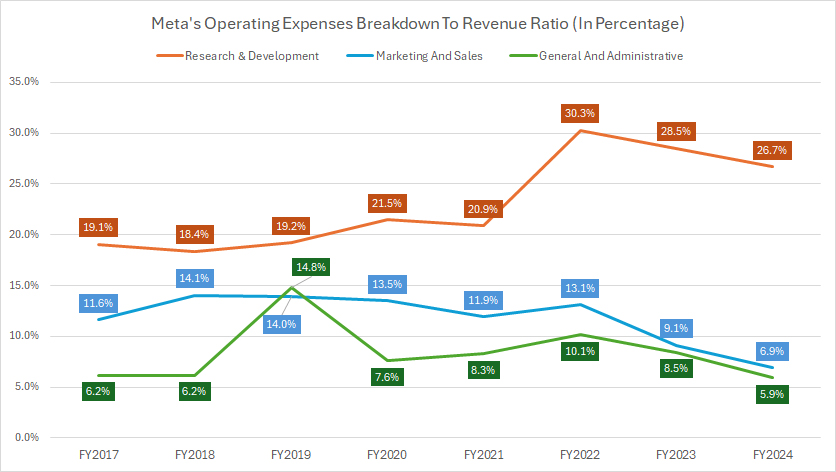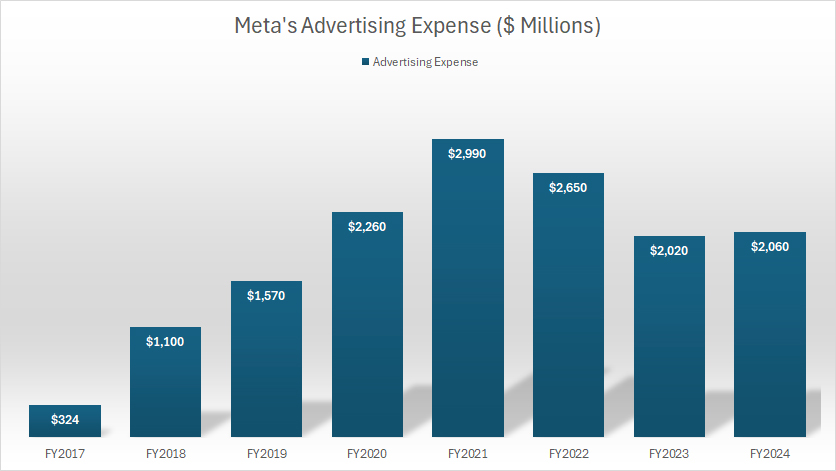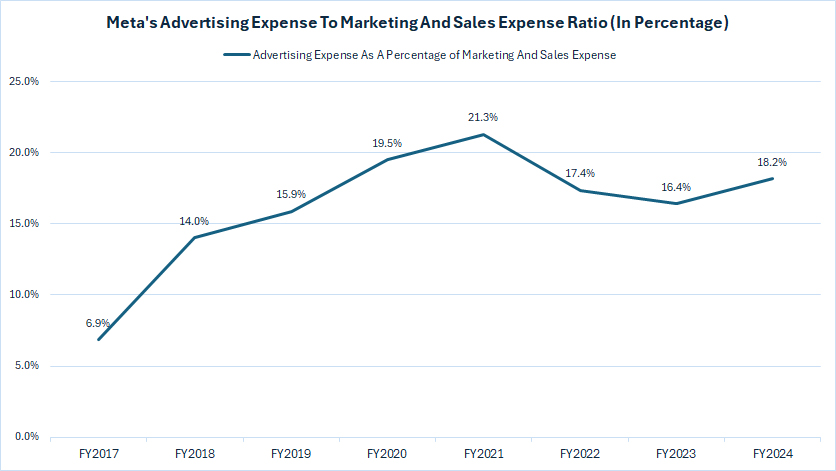
Social media like. Pexels Image.
Meta Platforms, Inc., (NASDAQ: META), incurs a significant portion of costs and expenses.
This article delves into the cost of revenue and operating expenses of the social media giant.
Let’s take a look!
You may find related statistic of Meta Platforms, Inc., on these pages:
- Meta revenue and profit by segment,
- Meta profit margin versus Snapchat, Pinterest, and Twitter, and
- R&D comparison among Meta, Twitter, Pinterest, and Snapchat.
Please use the table of contents to navigate this page.
Table Of Contents
Definitions And Overview
- Cost Of Revenue
- Operating Expenses
- Research And Development
- Marketing And Sales
- General And Administrative
- Advertising Expenses
O2. What contributes to the significant rise in Meta’s costs and expenses?
Consolidated Results
Breakdown Of Total Costs And Expenses
B1. Cost Of Revenue And Operating Expenses
B2. Percentage Of Cost Of Revenue And Operating Expenses
B3. Growth Rates Of Cost Of Revenue And Operating Expenses
Breakdown Of Operating Expenses
C1. R&D, Marketing And Sales, And General And Administrative Expenses
C2. Percentage Of R&D, Marketing And Sales, And General And Administrative Expenses
C3. Growth Rates Of R&D, Marketing And Sales, And General And Administrative Expenses
Ratio To Revenue
D1. Total Costs And Expenses To Revenue Ratio
D2. Operating Expenses And Cost Of Revenue To Revenue Ratio
D3. Operating Expenses Breakdown To Revenue Ratio
Advertising Spending
E1. Advertising Expense
E2. Advertising Expense As A Percentage Of Marketing And Sales
Conclusion And Reference
S1. Conclusion
S2. References and Credits
S3. Disclosure
Definitions
To help readers understand the content better, the following terms and glossaries have been provided.
Cost Of Revenue: Based on the 2023 annual report, Meta’s cost of revenue consists of expenses associated with the delivery and distribution of its products.
These mainly include expenses related to the operation of data centers and technical infrastructure, such as depreciation expense from servers, network infrastructure and buildings, as well as payroll and related expenses which include share-based compensation for employees on the company’s operations teams, and energy and bandwidth costs.
Cost of revenue also includes costs associated with partner arrangements, including traffic acquisition costs and credit card and other fees related to processing customer transactions; Reality Labs inventory costs, which consist of cost of products sold and estimated losses on non-cancelable contractual commitments; and content costs.
Operating Expenses: Operating expenses refer to the costs associated with the day-to-day operations of a business.
These expenses include rent, utilities, payroll, and costs related to the administration and general operations of the company. Operating expenses do not include costs associated with the production of goods or direct costs of services provided.
They are considered when calculating a company’s operating income and are crucial for analysing its financial health.
Research And Development Expenses: According to the 2023 annual report, Meta’s research and development expenses consist mostly of payroll and related expenses which include share-based compensation, Reality Labs technology development costs, facilities-related costs for employees on engineering and technical teams who are responsible for developing new products as well as improving existing products, and restructuring charges.
Marketing And Sales expense: According to the 2023 annual report, Meta’s marketing and sales expenses consist mainly of marketing and promotional expenses as well as payroll and related expenses which include share-based compensation for employees engaged in sales, sales support, marketing, business development, and customer service functions.
In addition, Meta’s marketing and sales expenses also include professional services such as content reviewers to support its community and product operations and restructuring charges.
General And Administrative Expenses: According to the 2023 annual report, Meta’s general and administrative expenses consist primarily of legal-related costs, which include estimated fines, settlements, or other losses in connection with legal and related matters, as well as other legal fees; payroll and related expenses which include share-based compensation for certain of its executives as well as legal, finance, human resources, corporate communications and policy, and other administrative employees; other taxes, such as digital services taxes and other non-income-based tax levies; professional services and restructuring charges.
Advertising Expenses: Advertising expense is the cost of promoting a product, service, or brand to potential customers. It is a type of expenditure that businesses incur to create awareness, generate interest, and ultimately drive sales.
This expense can take various forms, including but not limited to costs for online ads (such as social media and search engines), television and radio commercials, print advertisements (in magazines and newspapers), billboards, and other forms of media.
Advertising expenses are often categorized as operating expenses in financial statements and can significantly impact a company’s profitability depending on the strategy and budget allocated.
According to the 2023 annual report, Meta’s advertising costs are expensed when incurred and are included in marketing and sales expenses on its consolidated statements of income.
What contributes to the significant rise in Meta’s costs and expenses?
Meta’s costs and expenses have seen a significant rise due to several key factors:
- AI and Infrastructure Investments: Meta has been heavily investing in AI infrastructure, including data centers, servers, and networking equipment. This includes the development and deployment of custom Meta Training and Inference Accelerator chips.
- Reality Labs and Smart Glasses: The company is also focusing on its Reality Labs segment, which includes investments in smart glasses and other augmented reality (AR) and virtual reality (VR) technologies.
- Increased Headcount and Compensation: Higher infrastructure and headcount-related costs, including payroll and share-based compensation for employees, have contributed to the rise in expenses.
- Advertising and Marketing: Meta continues to spend significantly on advertising and marketing to maintain its competitive edge and grow its user base.
- Research and Development (R&D): The company allocates substantial resources to R&D to innovate and improve its products and services.
These investments are aimed at long-term growth and maintaining Meta’s competitive position in the tech industry. However, they also result in higher short-term costs and expenses.
Total Costs And Expenses
Meta-total-costs-and-expenses
(click image to expand)
Meta’s total costs and expenses reached $95.1 billion in fiscal year 2024, as reported in Meta’s 2024 annual report. This marks a significant increase from the $88.1 billion reported in fiscal year 2023.
Since 2017, Meta’s total costs and expenses have seen more than a fourfold rise, escalating from $20.5 billion in 2017 to $95.1 billion as of fiscal year 2024.
To understand the factors driving this surge, it’s essential to consider several critical areas of investment and expenditure by Meta, as presented in this section: growth of Meta’s costs and expenses.
Cost Of Revenue And Operating Expenses
Meta-cost-of-revenue-and-operating-expenses
(click image to expand)
Meta’s definitions of cost of revenue and operating expenses are available here: cost of revenue and operating expenses.
Meta’s total costs and expenses are primarily divided into two main categories: cost of revenue and operating expenses, as detailed in its annual reports.
The amount of Meta’s operating expenses significantly exceeds its cost of revenue. In fiscal year 2024, Meta’s operating expenses reached a staggering $65.0 billion, a slight increase from the $62.2 billion reported in fiscal year 2023. However, this figure represents more than a quadruple rise from the $15.0 billion reported in fiscal year 2017.
On the other hand, Meta’s cost of revenue totaled $30.1 billion in fiscal year 2024, which is less than half of the operating expenses for the same year. Despite being lower, the cost of revenue has also experienced substantial growth, rising from $5.5 billion in fiscal year 2017 to $30.1 billion in fiscal year 2024.
Meta’s operating expenses have surged due to various factors, including significant investments in AI infrastructure, Reality Labs, and an increased workforce. From fiscal year 2017 to 2024, operating expenses have risen by 333%, highlighting the company’s commitment to innovation and expansion.
The cost of revenue has grown at a slightly higher rate, increasing by approximately 447% over the same period. This rise can be attributed to the increased cost of content acquisition, data center operations, and other revenue-related expenses.
In short, Meta’s substantial growth in costs and expenses underscores the social media giant’s strategic investments and its ongoing efforts to drive long-term growth and maintain its competitive position in the tech industry.
Percentage Of Cost Of Revenue And Operating Expenses
Meta-percentage-of-cost-of-revenue-and-operating-expenses
(click image to expand)
Meta’s definitions of cost of revenue and operating expenses are available here: cost of revenue and operating expenses.
Meta’s operating expenses have consistently made up the bulk of the company’s total costs and expenses. In fiscal year 2024, operating expenses accounted for a notable 68% of the total costs and expenses. On average, from fiscal year 2022 to 2024, these expenses have represented approximately 70% of Meta’s total expenditures.
On the other hand, Meta’s cost of revenue has comprised a smaller portion of the company’s overall costs. In fiscal year 2024, the cost of revenue accounted for just 32% of the total costs and expenses. Over the last three years, the average ratio has been about 30%.
This allocation of expenses reflects Meta’s strategic focus on investing heavily in areas such as R&D, employee compensation and benefits, sales and marketing, and administrative and general expenses.
On the other hand, the cost of revenue primarily includes expenses directly related to generating revenue, such as content acquisition, data center operations, and bandwidth and other operational costs.
In summary, Meta’s operating expenses have consistently been the dominant component of its total costs, reflecting the company’s emphasis on long-term growth and innovation through substantial investments in R&D, workforce, and marketing.
Meanwhile, the cost of revenue, although smaller in proportion, has also seen significant growth, supporting the infrastructure and content necessary for revenue generation.
This strategic allocation ensures that Meta remains a formidable player in the tech industry.
Growth Rates Of Cost Of Revenue And Operating Expenses
Meta-growth-rates-of-cost-of-revenue-and-operating-expenses
(click image to expand)
Meta’s definitions of cost of revenue and operating expenses are available here: cost of revenue and operating expenses.
The growth of Meta’s cost of revenue and operating expenses has significantly slowed in recent years, as illustrated in the accompanying chart.
For instance, the growth rate of Meta’s cost of revenue measured just 2.8% in fiscal year 2023, a marked decline from the 11.5% growth seen in 2022 and the 35.7% surge in 2021. However, fiscal year 2024 saw a notable rebound, with the cost of revenue increasing by 16% year-on-year.
Conversely, Meta’s operating expenses actually decreased by 0.4% in fiscal year 2023, in stark contrast to the substantial growth rates of 28.6% in 2022 and 32.6% in 2021. In fiscal year 2024, operating expenses grew by 4.5%, still a relatively modest increase compared to previous years.
This trend suggests that Meta has significantly curtailed its cost of revenue and operating expenses in the post-COVID period, with growth rates reaching record lows in recent years for both categories of expenses.
This strategic shift likely reflects Meta’s efforts to optimize its cost structure and focus on sustainable growth. Several factors contribute to this slowed growth.
For example, Meta has likely implemented various efficiency measures to streamline operations and reduce unnecessary expenditures. Also, the company may have shifted its focus to more strategic investments, selectively allocating resources to high-impact areas while reducing spending in less critical areas.
Besides, the advances in technology and automation could have helped Meta achieve cost savings, particularly in areas such as data center operations and content delivery.
In summary, Meta’s deliberate efforts to manage its cost of revenue and operating expenses have resulted in a significant slowdown in their growth rates. This prudent approach to cost management positions Meta for sustained growth and stability in a rapidly evolving tech landscape.
R&D, Marketing And Sales, And General And Administrative Expenses
Meta-operating-expenses-breakdown
(click image to expand)
Meta’s definitions of R&D, marketing and sales, and general and administrative expenses are available here: R&D, marketing and sales, and general and administrative.
Meta’s operating expenses are categorized into three major areas: research and development (R&D), marketing and sales, and general and administrative, as outlined in its annual reports.
Among these categories, Meta’s research and development expense is the largest. Meta’s R&D expense reached a substantial $43.9 billion in fiscal year 2024. Since 2017, this figure has surged dramatically, increasing sixfold in just eight years.
Meta’s R&D spending has continued to increase with no signs of slowing down, reflecting Meta’s commitment to innovation and technological advancements. Since fiscal year 2022 alone, R&D expenses have surged by 24%, or nearly $9 billion.
Meta’s marketing and sales expense forms the second-largest portion of its operating expenses. In fiscal year 2024, this expense totaled $11.3 billion, reflecting significant growth since 2017. However, it peaked at $15.2 billion in fiscal year 2022 before declining in subsequent years.
General and administrative costs are the smallest among the three categories. In fiscal year 2024, these expenses amounted to $9.7 billion. Similar to marketing and sales expenses, general and administrative costs have significantly increased since 2017, peaking at $11.8 billion in fiscal year 2022 before experiencing a decline.
The overall slowdown in the growth of marketing and sales, as well as general and administrative expenses, suggests Meta’s strategic shift towards optimizing its cost structure and focusing on sustainable growth post-COVID.
Despite the declines in these areas, Meta’s R&D expenses have continued to rise, underlining the company’s dedication to long-term innovation and maintaining its competitive edge in the technology sector.
In summary, Meta’s operating expenses, particularly R&D, play a crucial role in its strategy for sustained growth and innovation.
While marketing and sales, as well as general and administrative expenses, have experienced fluctuations and recent declines, R&D spending remains a priority, ensuring Meta’s continuous advancement in the tech landscape.
Percentage Of R&D, Marketing And Sales, And General And Administrative Expenses
Meta-operating-expenses-breakdown-in-percentage
(click image to expand)
Meta’s definitions of R&D, marketing and sales, and general and administrative expenses are available here: R&D, marketing and sales, and general and administrative.
Meta’s R&D expenses constitute the largest portion of the company’s operating expenses, consistently accounting for more than 60% of the total over the past several years.
In fiscal year 2024, R&D expenses represented 67.5% of the total operating expenses, the highest percentage ever recorded. This marks a significant increase from 51.7% in fiscal year 2017 to 67.5% as of fiscal year 2024.
The rising share of R&D in Meta’s operating expenses underscores the critical importance of research and development to the company’s strategy and long-term goals. It indicates that Meta places the highest priority and attention on this category compared to other expenses.
In contrast, the percentage of Meta’s marketing and sales expenses has considerably declined over the past eight years, dropping from 31.5% in fiscal year 2017 to just 17.5% in fiscal year 2024.
This downward trend suggests a strategic shift in resource allocation away from marketing and sales towards areas deemed more vital for future growth.
Similarly, Meta’s general and administrative expenses peaked at 30.8% of the total operating expenses in fiscal year 2019. Since then, they have been on the decline, reaching only 15% as of fiscal year 2024.
This reduction highlights Meta’s efforts to streamline administrative costs and improve operational efficiency.
In summary, Meta’s operating expenses have evolved significantly over the years, with R&D consistently rising in importance and proportion. This trend highlights the company’s dedication to innovation and strategic investment in future technologies.
Growth Rates Of R&D, Marketing And Sales, And General And Administrative Expenses
Meta-growth-rates-of-operating-expenses-breakdown
(click image to expand)
Meta’s definitions of R&D, marketing and sales, and general and administrative expenses are available here: R&D, marketing and sales, and general and administrative.
Meta’s R&D expenses stand out as the only category of operating expenses to consistently register positive growth rates across all periods.
However, the growth rate for R&D expenses slowed to just 8.9% in fiscal year 2023 and 14% in fiscal year 2024, marking some of the lowest growth rates observed over the past eight years.
On average, Meta’s R&D expenses grew by 22% annually between fiscal years 2022 and 2024. Although this represents a significant decline compared to previous years, R&D expenses still show the most substantial growth rate among the various categories of operating expenses.
In contrast, Meta’s marketing and sales expenses experienced an 8% decrease in fiscal year 2024. Similarly, general and administrative expenses saw a notable 15% year-on-year decrease in the same period.
Between fiscal years 2022 and 2024, Meta’s marketing and sales expenses decreased by an average of 6% annually, while general and administrative expenses remained relatively flat during the same period.
The continuous positive growth in R&D expenses, albeit at a reduced rate, underscores Meta’s strategic emphasis on research and development as a core driver for future growth.
The decline in marketing and sales, as well as general and administrative expenses, signals a deliberate effort to optimize resource allocation and enhance cost efficiency post-COVID.
In summary, Meta’s operating expenses reveal a clear focus on R&D, with growth in this area outpacing other categories, despite recent slowdowns.
Total Costs And Expenses To Revenue Ratio
Meta-total-costs-and-expenses-to-revenue-ratio
(click image to expand)
Meta’s total costs and expenses consumed approximately 58% of its total revenue in fiscal year 2024. This ratio was significantly higher at 75% in fiscal year 2022 and 65% in fiscal year 2023. On average, Meta’s total costs and expenses have accounted for 66% of its total revenue over the last three years.
Since 2017, Meta’s ratio of total costs and expenses to revenue has consistently increased, pointing to faster growth in expenses compared to revenue.
This trend underscores the challenges Meta has faced in managing its expanding cost base while striving to grow its revenue. The peak ratio of 75% in fiscal year 2022 marked a turning point, with Meta subsequently implementing measures to reduce costs.
The decline to 65% in fiscal year 2023 and further to 58% in fiscal year 2024 indicates Meta’s determination and success in cutting costs and optimizing its expense management.
Meta’s ongoing efforts to control costs and expenses are evident in the decreasing ratios over recent years. These adjustments reflect a strategic shift towards achieving a more sustainable balance between revenue growth and expense management.
In summary, Meta’s total costs and expenses as a percentage of revenue have shown significant fluctuations over the past few years. The peak in fiscal year 2022 prompted a focused effort to reduce expenses, resulting in a notable decline in subsequent years.
This trend highlights Meta’s commitment to optimizing its financial performance and achieving long-term sustainability.
Operating Expenses And Cost Of Revenue To Revenue Ratio
Meta-cost-of-revenue-and-operating-expenses-to-revenue-ratio
(click image to expand)
Meta’s definitions of cost of revenue and operating expenses are available here: cost of revenue and operating expenses.
Within Meta’s costs and expenses, operating expenses have consistently consumed the largest portion of revenue. This ratio peaked at 54% of sales in fiscal year 2022.
Since fiscal year 2022, Meta’s operating expenses-to-revenue ratio has gradually decreased, reaching 39.5% in fiscal year 2024. This indicates a more balanced alignment of operating expenses in relation to revenue.
Conversely, Meta’s cost of revenue accounted for just 18.3% of sales in fiscal year 2024, down from 21.7% in fiscal year 2022.
Both operating expenses and cost of revenue ratios have significantly declined after peaking in fiscal year 2022. This reduction points to Meta’s effective cost-cutting measures and strategic focus on optimizing expenditures in post-pandemic periods.
Despite recent declines, the long-term trend shows that both expenses have increased much faster than revenue compared to eight years ago. This escalation illustrates the challenges Meta faced in managing its cost structure during periods of rapid growth and investment.
In summary, while Meta’s operating expenses and cost of revenue ratios have both seen significant declines since their peak in fiscal year 2022, they remain higher compared to levels eight years ago, especially for the cost of revenue.
Operating Expenses Breakdown To Revenue Ratio
Meta-operating-expenses-breakdown-to-revenue-ratio
(click image to expand)
Meta’s definitions of R&D, marketing and sales, and general and administrative expenses are available here: R&D, marketing and sales, and general and administrative.
Within Meta’s operating costs, the research and development (R&D) expense has consumed a significant portion of revenue, totaling 26.7% of sales in fiscal year 2024. This makes R&D the largest expense category relative to revenue.
Over the past eight years, Meta’s R&D expenses have increased substantially as a percentage of revenue, rising from 19% in fiscal year 2017 to 26.7% in fiscal year 2024. This growth underscores Meta’s strategic emphasis on innovation and technological advancement.
In contrast, Meta’s marketing and sales expenses have seen a decline relative to revenue. In fiscal year 2024, marketing and sales expenses accounted for just 7% of revenue, down from 11.6% in fiscal year 2017.
Similarly, general and administrative expenses comprised 6% of revenue in fiscal year 2024, showing a stable trend over the long term.
Meta’s R&D expenses have consistently been the largest portion of operating costs relative to revenue. The increasing share of R&D expenditures highlights Meta’s commitment to driving innovation and maintaining its competitive edge.
Over the past eight years, R&D expenses have shown the most significant growth relative to revenue, while marketing and sales, as well as general and administrative expenses, have either declined or remained stable.
This trend illustrates Meta’s strategic focus on innovation while optimizing other expense categories for better financial performance.
In summary, Meta’s operating expense breakdown reveals a clear emphasis on R&D, with this category consuming the largest share of revenue and showing consistent growth.
Advertising Expense
Meta-advertising-expense
(click image to expand)
Meta’s definitions of advertising spending are available here: advertising expense.
Although Meta derives the majority of its revenue from advertising, it also allocates a considerable budget to its own advertising efforts.
As shown in the chart above, Meta’s advertising expenses exceeded $2 billion in fiscal year 2023 and averaged $2.2 billion over the last three years.
Since fiscal year 2021, Meta has made significant cuts to its advertising budget. The most notable reduction was a nearly $1 billion decrease, from nearly $3 billion in fiscal year 2021 to $2 billion in fiscal year 2023.
The significant cut in advertising spending demonstrates Meta’s commitment to cost management and efficiency. By reducing its advertising budget, Meta can redirect funds to other critical areas, such as R&D or infrastructure development.
The decline in advertising expenses post-fiscal year 2021 aligns with broader trends of optimizing marketing strategies and improving return on investment. This adjustment ensures that advertising efforts are more targeted and effective.
In summary, while Meta continues to generate the majority of its revenue from advertising, the company has also implemented significant reductions in its own advertising spending.
Advertising Expense As A Percentage Of Marketing And Sales
Meta-advertising-expense-to-marketing-and-sales-expense-ratio
(click image to expand)
Meta’s definitions of advertising spending are available here: advertising expense.
According to Meta’s annual reports, the company’s advertising expenses are included within its marketing and sales expense category.
As such, Meta’s advertising spending of $2 billion in fiscal year 2024 accounted for roughly 18% of the total marketing and sales expense.
The ratio of advertising expenses to marketing and sales expense has decreased slightly from the peak of 21.3% recorded in fiscal year 2021.
This downward trend indicates a reduction in advertising spending as a proportion of the overall marketing and sales budget.
Meta’s reduction in advertising spending reflects strategic adjustments aimed at optimizing resource allocation. By reallocating funds, Meta can invest more in other critical areas, such as R&D and technological advancements.
In summary, Meta’s advertising expenses, as a part of its marketing and sales category, have shown a decreasing trend in recent years.
The percentage of advertising spending relative to the total marketing and sales expense has declined from its peak in fiscal year 2021, averaging 17% over the past three years.
This trend highlights Meta’s strategic focus on optimizing its advertising budget and reallocating resources to support other critical growth initiatives.
Conclusion
Meta’s cost of revenue and operating expenses have evolved significantly over the years. While the company has made substantial investments in R&D, marketing, and sales, it has also implemented strategic cost-cutting measures to optimize its expenses. The overall trend shows a focus on innovation and efficiency, ensuring sustainable growth and financial stability.
References and Credits
1. All financial figures presented are obtained from Meta’s annual reports published on the company’s investor relations page: Meta Investor Relations.
2. Pexels Images.
Disclosure
We may utilize the assistance of artificial intelligence (AI) tools to produce some of the text in this article. However, the data is directly obtained from original sources and meticulously cross-checked by our editors multiple times to ensure its accuracy and reliability.
If you find the information in this article helpful, please consider sharing it on social media. Additionally, providing a link back to this article from any website can help us create more content like this in the future.
Thank you for your support and engagement! Your involvement helps us continue to provide high-quality, reliable content.

